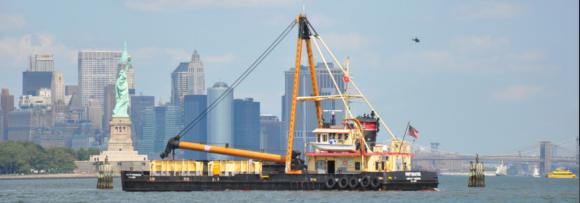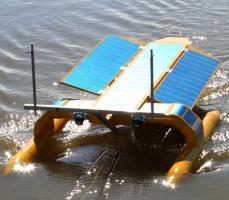
DCV Driftmaster, Photo: Chris Gardner
As the problem of trash and plastic in our waters gets worse, new (and a few older technologies) are being used to respond. They range from small and functional, like the Seabin, a sort of high tech floating bucket designed to collect floating trash in marinas, to RanMarine‘s Waste Shark, an autonomous surface drone which the developers describe as “trash-eating, data-collecting, carbon-zero and safe.”
RanMarine Technology – The WasteShark
 On the other end of the scale, a team of inventors at Bluebird Marine Systems from Sussex, England, are working to develop the SeaVax, a 144′ long solar-and wind-powered autonomous ship that can suck up, shred and compact plastic and other waste. Bluebird Marine Systems unveiled their proof of concept at the Innovate UK show in London in November, a year ago.
On the other end of the scale, a team of inventors at Bluebird Marine Systems from Sussex, England, are working to develop the SeaVax, a 144′ long solar-and wind-powered autonomous ship that can suck up, shred and compact plastic and other waste. Bluebird Marine Systems unveiled their proof of concept at the Innovate UK show in London in November, a year ago.
“With our system all sizes of rubbish, from huge fishing nets to deadly micro particles, can be swept or sucked up, ground down and stored in SeaVax’s tanks,” explains project director Chris Close.
The Waste Shark and the SeaVax are both catamaran designs intended to scoop up plastic and debris from harbors and oceans. Both are relatively high tech and sophisticated. Nevertheless, the concept is not new. In New York harbor, a 100′ long catamaran vessel has been scooping up debris from the water around 70 years.
The United States Army Corps of Engineers (USACE) Drift Collection Vessel DCV Driftmaster has helped keep New York harbor and the Hudson River navigable by removing all manner of flotsam and jetsom which would otherwise threaten vessels operating on the waterway. Driftmaster has been operating in the harbor since 1948 and is still going strong.

The Seabin is a tad salty at 3.3K eurothingies. I can’t see your average Marina paying the equivalent of a one years berth fee for one and then having to persuade the staff to empty it twice a day. They don’t even bother to use a scoop net in the corner where all the waste collects which is essentially all this thing is doing. As they would say on Dragon’s Den: I’m out.
Nothing is zero carbon!
Most plastics are made from oil and chemicals. Batteries used carbon to make them.
ETC.